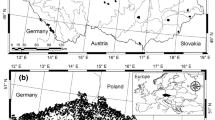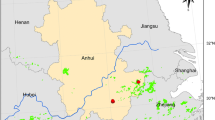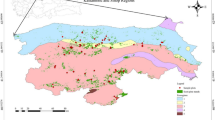Abstract
Using permanent sample-plot data, selected tree height and diameter functions were evaluated for their predictive abilities for major tree species in complex (multiple age, size and species cohort) stands of interior British Columbia (BC), Canada. Two sets of models were evaluated. The first set included five models for estimating height as a function of individual tree diameter, the second set also included five models for estimating height as a function of individual tree diameter and other stand-level attributes. The inclusion of the BAL index (which simultaneously indicates the relative position of a tree and stand density) into the base height–diameter models increased the accuracy of prediction for all species. On average, by including stand level attributes, root mean square values were reduced by 30.0 cm. Based on the residual plots and fit statistics, these models can be recommended for estimating tree heights for major tree species in complex stands of interior BC. The model coefficients are documented for future use.
Similar content being viewed by others
Avoid common mistakes on your manuscript.
Introduction
The ability to predict the growth and yield of trees and forests is an essential requirement for effective management of forest resources. In complex forests where trees of various ages, species, sizes, vigour and crown classes, and shade-tolerance levels co-exist, yield predictions are more difficult than in uniform stands. In complex stands, individual tree height–diameter relationships and predictions are often further complicated by selective harvesting and other disturbances and by changing stand dynamics (Oliver and Larson 1990).
The estimation of stand development over time relies on accurate height–diameter functions. Many growth and yield models require height and diameter as basic input variables, with all or part of the tree height predicted from measured diameters (Burkhart et al. 1972; Wykoff et al. 1982; Huang et al. 1992). When actual height measurements are not available, height–diameter functions can also be used to indirectly predict height growth (Larsen and Hann 1987). For example in the simulator known as PrognosisBC (a growth model fitted for complex stands in the interior of BC), missing heights are directly predicted using specific height–diameter equations (Temesgen and LeMay 1999). These equations do not include additional variables that may influence the height–diameter relation in different stands.
A generalized height–diameter function estimates the specific relationship between individual tree heights and diameters using stand variables such as basal area per hectare and quadratic mean diameter. The reason for using them is to avoid having to establish individual diameter–height relationships for every stand (Curtis 1967). In Europe, generalized height–diameter functions, known as Einheitshöhenkurven in the German language, have been used since the 1930’s (Lang 1938; Kramer 1964; von Laer 1964; Kennel 1972; Nagel 1991; Hui and Gadow 1993). The objective of this paper is to assess the predictive abilities of selected generalized height–diameter models in complex stands. As an example, data for major tree species of the interior of BC are used. The study specifically evaluates the contribution of stand-density variables in estimating height–diameter relationships.
Methods
Data
Permanent sample-plot (PSP) data were supplied by the BC Ministry of Forests, Forest Practices Branch. The PSPs were developed to document tree and stand growth and mortality over time in the interior Douglas fir (IDF) biogeoclimatic ecosystem classification (BEC) zone for over 30 years. They were laid out as fixed area plots covering 400 m2 each and represent a variety of stand structures, species compositions, densities and site qualities in the IDF BEC zone, situated between 49° and 52°30′N latitude with mean annual temperature and precipitation ranging from 1.6–9.5 °C and 75–300 mm (Meidinger and Pojar 1991). PSPs that had been affected by complete or partial disturbances such as thinning, juvenile spacing or selective logging were excluded from further analysis. From the entire data set (i.e. the first and subsequent remeasurements), only live trees with measured height values were selected and used in this analysis.
Trees with less than 2.0-cm diameter outside bark at 1.3 m aboveground (D) were not recorded in the PSP data set. Since the number of small trees (<7.5-cm diameter with measured height values) by species were not adequate, the PSP data set was augmented by the small-tree data that were collected between 1999 and 2001 (Boisvenue 1999; Froese et al. 2001; Hasani et al. 2001; Lencar and Marshall 2000). From each PSP, heights and diameters were extracted and combined with the small-tree data set. Subsequently, the combined data were used to assess and evaluate selected height–diameter functions. The diameters and heights of repeated measurements were used as independent observations for fitting and evaluating the height–diameter functions. Autocorrelation in the remeasured PSP data set was ignored, as the impact of variance underestimation is likely masked by fitting each individual tree as an independent observation (Hamilton and Edwards 1976). Thus the inclusion of the small trees measured once is justifiable and provides a practical (and a better) generalized height–diameter model for each species considered in the study.
Height–diameter functions by tree species
Differences were found among the estimated model parameters and the predictive ability of the height–diameter models when functions were first fitted by species (Temesgen and LeMay 1999). Based on a literature review, two sets of height–diameter functions were assessed for their predictive abilities. The first set included five models for estimating height as a function of diameter only. The second set also included five models, but height was estimated not only as a function of diameter but included stand-level attributes. Since the height–diameter functions are expected to vary by tree species, the selected models were fitted by species, and compared for accuracy. To obtain stable parameter estimates, only species represented by more than 30 trees were included in this study. After assessing several height–diameter functions, the following ten functions were evaluated.
- Model 1:
-
Wykoff et al. (1982)
where a and b are species-dependent coefficients, Ĥ is estimated tree height in metres, D is the observed diameter outside bark at breast height in centimetres, and e is the Naperian constant (i.e. 2.718). Model 1 is the height–diameter equation used for estimating tree-height values in the northern Idaho version of Prognosis.
- Model 2:
-
Yang et al. (1978)
Model 2 is a Weibull-type function. In Huang et al. (1992), this function was consistently the best among the 19 height–diameter functions they tested. The parameters a, b and c are species dependent.
- Model 3:
-
Ratkowsky (1990)
Model 3 is similar to model 1. The parameters a, b and c are species dependent. Flewelling and de Jong (1994) also used this function to estimate missing heights in the BC PSP data sets.
- Model 4:
-
modified from Hui and Gadow (1993)
- Model 5:
-
modified from Hui and Gadow (1993)
The Chapman-Richards function has been extensively used in describing height–age relationship. Huang et al. (1992) gave a cautionary note, however, stating that this function approaches the asymptote too quickly when there is a weak relationship between the dependent and independent variables. Accordingly, this model was not selected in this study.
Since the relationship between diameter and height is influenced by the relative competitive position of the trees and by stand-density variables, several relevant model forms, including those used by Huang and Titus (1994) and Staudhammer and LeMay (2000), were evaluated. Based on their preliminary results, the following variables and model forms were selected to fit the generalized height–diameter functions.
- Model 6:
-
where a 1 to a 6 are species-dependent coefficients; BAL is the basal area in larger trees (m2/ha); SPH is number of trees per hectare; and BA is basal area per hectare (m2/ha).
- Model 7:
-
where a 1 to a 6 are species-dependent coefficients.
- Model 8:
-
Ratkowsky (1990) with stand-level attributes
where a 1 to a 6 are species-dependent coefficients.
- Model 9:
-
modified from Hui and Gadow (1993)
where Dq is quadratic mean diameter (cm).
- Model 10:
-
modified from Hui and Gadow (1993)
While the first five models used D as the only independent variable, the generalized (last five) models used D, relative position of trees, and stand density as predictor variables. To obtain stable parameter estimates, only species that were represented in more than 25 PSPs were included in this study.
Model parameters were estimated using the Gauss-Newton optimization technique (Gallant 1987) in a non-linear least-squares procedure with SAS software (PROC NLIN, SAS Institute, Inc. 1990). In order to find a global minimum, the starting value of each parameter was varied, thus obtaining several runs. Initial approximations for each parameter were obtained from linear transformation of the models where possible. The assumption of homoscedasticity was tested using the Goldfield-Quandt test (Goldfield and Quandt 1965). The test indicated homogenous variances over the full range of predicted values at 0.05 α-level (Fig. 1).
Model comparison and selection
After parameter estimates were obtained, the predictive abilities of the selected height–diameter functions were evaluated using the bias and root mean square error (RMSE) criteria, the asymptotic t-statistics of the parameters and the asymptotic 95% confidence intervals.
The bias and RMSE values were obtained by:
where n is the number of trees of a given species, H i is measured height, and Ĥ i is estimated height.
where p is the number of parameters in the model.
After evaluating the results, one model was selected for future use in PrognosisBC. For the selected model, parameter estimates and their fit statistics are provided.
Results and discussion
Data summary
Selecting species with more than 30 trees resulted in a total sample of 12,114 individual trees. The sample trees were used to estimate the model parameters for eight different species. The data set covered a wide range of tree sizes with diameters ranging from 2.0 to 104.0 cm and standard deviations from 6.7 to 12.6 cm. Tree heights ranged from 1.4–39.4 m and their standard deviations from 5.6–9.0 m (Table 1).
Model fitting by species
Noticeable differences were found among the predictive abilities of the height–diameter equations by species. The RMSE values (m) ranged from 1.7– 3.2, 1.6–2.9, 1.7–3.1, 1.7–3.2, and 2.3–4.4 for models 1 through 5, respectively. For models with stand-level attributes, the RMSE values (m) ranged from 1.5–2.8, 1.4–2.6, 1.4–2.7, 2.1–4.6, and 1.9–3.9 for models 5 through 8 (Table 2). None of the investigated models were biased (Table 3).
For species occurring in more than 25 PSPs, the inclusion of relative position of a tree and stand-density variables improved the predictive abilities of models 6 through 10. On average, the addition of these variables to the height–diameter functions reduced the RMSE by 30.0 cm.
Model comparison and selection
When height–diameter functions were refitted by species, differences were found among the estimated model parameters and the predictive ability of the height–diameter models. Among the five base models, model 2 had the lowest RMSE values for most species. Among the models tested with stand-level attributes, model 7 (the counterpart to model 2) had the lowest RMSE values for most species (Table 2).
Judging from the residual plots and the RMSE values, model 7 and its base model (model 2) generally performed better than the remaining models. For both models 2 and 7, the confidence intervals for some parameters included zero; the model was then refitted using only the significant variables. The refitted models showed small RMSE and approximately homogenous variances over the full range of predicted values (Fig. 1), indicating equal variances and reasonable model specification. The residual plots also indicated that tree height was well predicted across diameters. The residual plots against the predicted height and diameter for model 7 clearly show that the function appropriately fits the data for major trees in complex stands of interior BC (Fig. 1).
The parameter estimates obtained for models 2 and 7 varied widely (Tables 4 and 5) and show significant t-statistics for all species. Models 2 and 7 have the flexibility to assume various shapes with different parameter values and produce satisfactory relationships under most circumstances. The relationship is biologically reasonable: unrealistic height predictions do not occur beyond the range of the empirical observations.
Conclusions and recommendations
Tree height is an important variable which is used for estimating stand volume and site quality and for describing stand vertical structure. Measuring tree heights is costly however, and foresters usually welcome an opportunity to estimate this variable with an acceptable accuracy. Missing heights may be estimated using a suitable height–diameter function. Based on a comprehensive data set which includes very small diameters, such height–diameter functions were fitted for eight major tree species in complex stands of interior BC. The inclusion of relative position of a tree and stand-density variables into the base height–diameter function increased the accuracy of prediction for most species. For both conifers and hardwood tree species, the fit statistics indicated that models 2 and 7 are most suitable for predicting tree heights from a diameter–stand table. The parameter estimates using models 2 and 7 will provide reasonable precision and therefore these models can be recommended for unthinned stands in interior BC. Due to the kind of data used, the suggested height curves should not be used in thinned stands or stands with juvenile spacing or selective logging, and not in model predictions which contain any of these treatments.
The relative position and stand-density measures used in this study are easily obtained and are available in most growth and yield models. When these variables were added to the base model 2, the root mean square values were reduced by 30.0 cm on the average. Where possible, the use of the height–diameter function with these attributes is suggested. In summary, the suggested model improves the accuracy of height prediction, ensures compatibility among the various estimates in a growth and yield model, and maintains projections within reasonable biological limits.
References
Boisvenue C (1999) Early height growth and regeneration: applicability of prognosis components to the southern interior of British Columbia. Master’s Thesis, University of British Columbia, Vancouver
Burkhart HE, Parker RC, Strub MR, Oderwald MR (1972) Yield of old-field loblolly pine plantations. School of Forestry and Wildlife Resources, Virginia Polytechnic Institute and State University, Blacksburg, Publication FWS-3-72
Curtis RO (1967) Height-diameter and height-diameter-age equations for second-growth Douglas-fir. For Sci 13:365–375
Flewelling JW de Jong RD (1994) Considerations in simultaneous curve fitting for repeated height-diameter measurements. Can J For Res 24:1408–1414
Froese K, LeMay V, Marshall PL, Zumrawi A (2001) PrognosisBC calibaration in the IDFdm2, Invermere Forest District: field sampling. Report to the B.C. Science Council, Burnaby
Gallant AR (1987) Nonlinear statistical models. Wiley, New York
Goldfield SM, Quandt RE (1965) Some tests for homoscedasticity. J Am Stat Assoc 60:539–547
Hamilton DA, Edwards BM (1976) Modeling the probability of individual tree mortality. USDA Forest Service Research Paper INT-185, Intermountain Forest and Range Experiment Station, Ogden, UT
Hasani BT, Marshall PL, LeMay V, Temesgen H (2001) Development of regeneration imputation models for the ICHmw2 in the vicinity of Nelson. Report to the BC Science Council, Burnaby
Huang S, Titus SJ (1994) An age-independent individual tree height prediction model for boreal spruce-aspen stands in Alberta. Can J For Res 24:1295–1301
Huang S, Titus SJ, Wiens DP (1992) Comparison of nonlinear height-diameter functions for major Alberta tree species. Can J For Res 22:1297–1304
Hui GY, Gadow K v (1993) Zur Entwicklung von Einheitshöhenkurven am Beispel der Baumart Cunninghamia lanceolata. Allg Forst Jagdztg 164 12:218–220
Kennel E (1972) Waldinventur und Holzaufkommensprognose für Bayern. Allg Forstz 615–616
Kramer H (1964) Die Genauigkeit der Massenermittlung nach dem “Reihenverfahren”—zu dem gleichlautenden Beitrag von Oberforstmeister von Laer. Forst Holzwirt 140–141
Lang A (1938) Bestandeseinheitshöhenkurven der Württembergischen Forsteinrichtungsanstalt. Allg Forst Jagdztg 168–176
Larsen DR, Hann DW (1987) Height-diameter equations for seventeen tree species in southwest Oregon. Oregon State University Forest Research Laboratory, Corvallis, Research Paper 49
Lencar C, Marshall PL (2000) Small tree height growth and stocking in the IDF dk1, dk2, dk3 subzones, Kamloops and Cariboo Forest Regions. Report to the Forest Practices and Research Branches, BC, Ministry of Forests, Victoria
Meidinger D, Pojar J (1991) Ecosystems of British Columbia. BC Ministry of Forests, Victoria
Nagel J (1991) Einheitshöhenkurvenmodell für Roteiche. Allg Forst Jagdztg 1:16–18
Oliver CD, Larson BC (1990) Forest stand dynamics. McGraw Hill, New York
Ratkowsky DA (1990) Handbook of nonlinear regression. Marcel and Dekker, New York
SAS Institute Inc. (1990) SAS/STAT User’s Guide, Version 6, vol 2, 4th edn. Cary, NC
Staudhammer C, LeMay V (2000) Height prediction equations using diameter and stand density measures. For Chron 76:303–309
Temesgen H, LeMay VM (1999) Examination of tree height and diameter increment models fitted for PrognosisBC. A report submitted to the Forest Practices Branch, BC Ministry of Forests, Victoria, BC
von Laer W (1964) Die Genauigkeit der Massenermittlung nach dem “Reihenverfahren”. Forst Holzwirt 139–140
Wykoff WR, Crookston NL, Stage AR (1982) User’s guide to the stand prognosis model. USDA Forest Service General Technical Report INT-133, Ogden, UT
Yang RC, Kozak A, Smith JHG (1978) The potential of Weibull-type functions as flexible growth curves. Can J For Res 8:424–431
Acknowledgements
We gratefully acknowledge the cooperation and financial support provided by the German Academic Exchange Program (DAAD), the British Columbia Ministry of Forests and University of British Columbia. We thank Drs. V. LeMay and P.L. Marshall for their comments on an earlier draft, and two anonymous referees for constructive comments. Part of this analysis was carried out when the lead author was a visiting scientist at the University of Göttingen, Germany.
Author information
Authors and Affiliations
Corresponding author
Rights and permissions
About this article
Cite this article
Temesgen, H., v. Gadow, K. Generalized height–diameter models—an application for major tree species in complex stands of interior British Columbia. Eur J Forest Res 123, 45–51 (2004). https://doi.org/10.1007/s10342-004-0020-z
Received:
Accepted:
Published:
Issue Date:
DOI: https://doi.org/10.1007/s10342-004-0020-z






